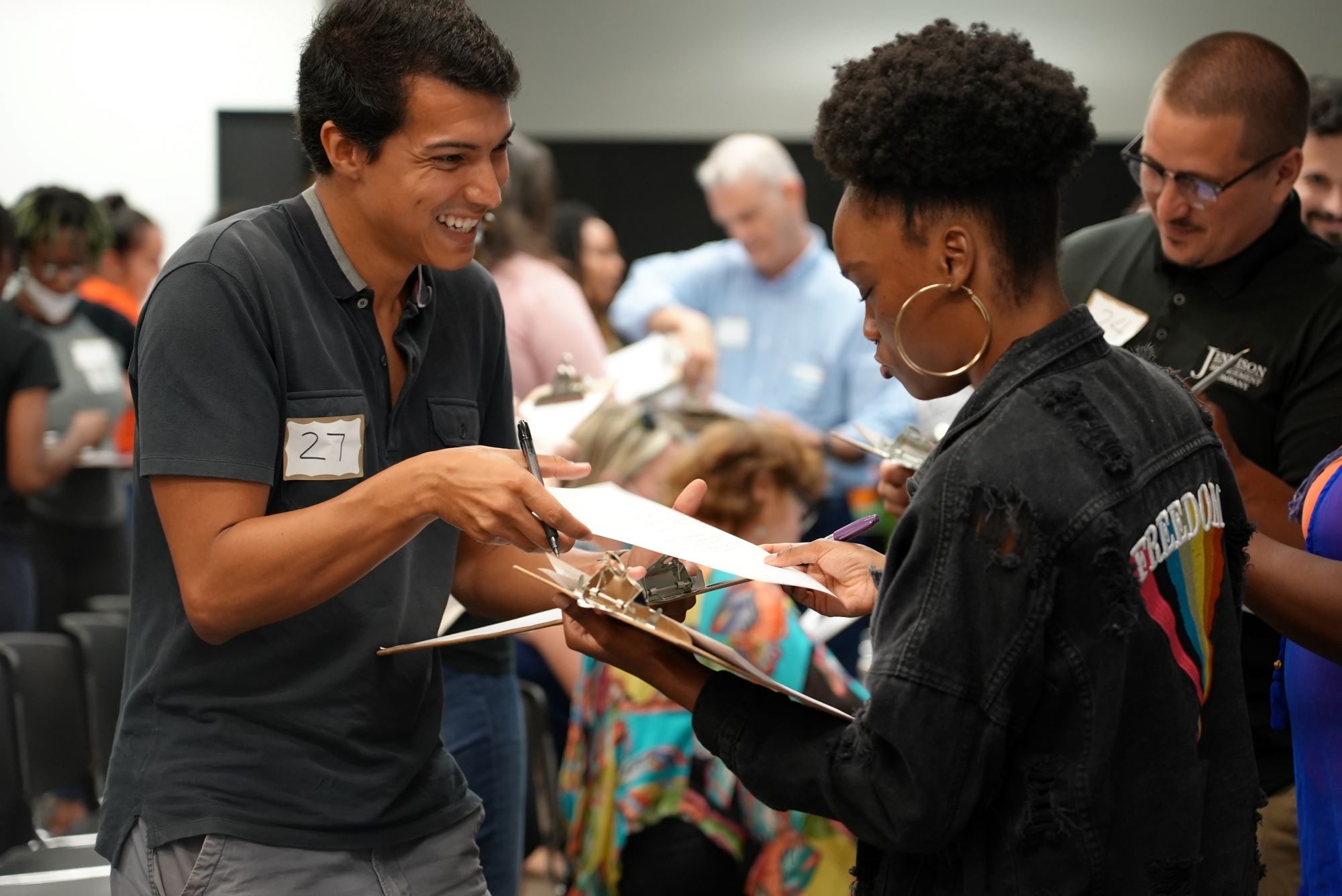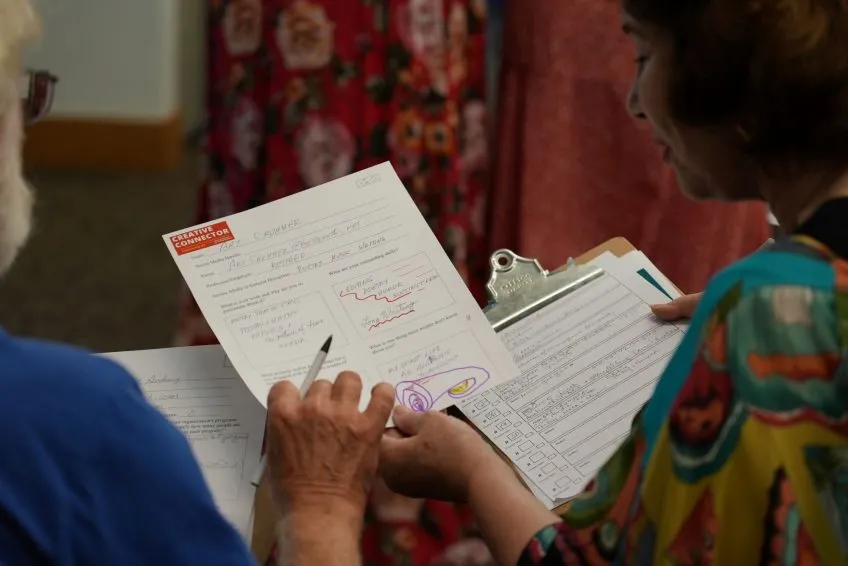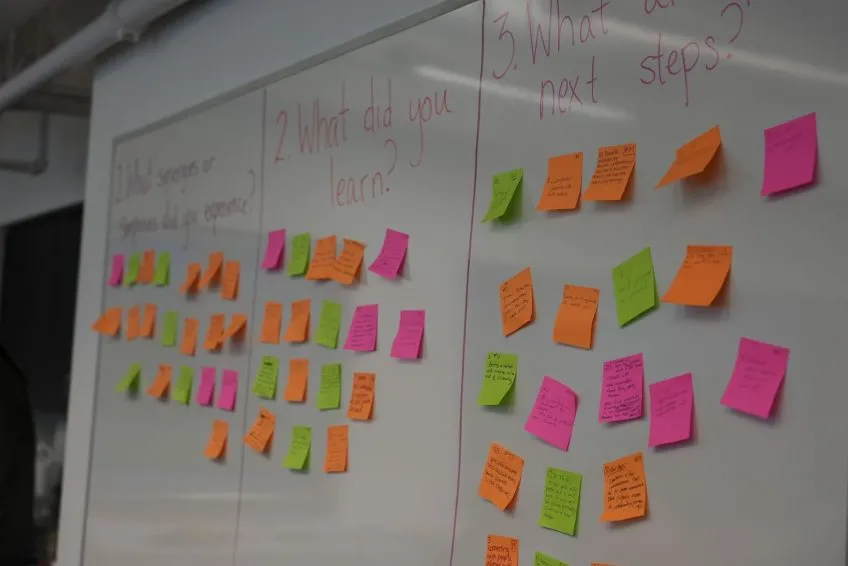City of Gainesville, UF Center for Arts in Medicine participate in One Nation/One Project, ‘Arts For EveryBody’ national initiative

On October 27, 1936, 18 cities across the United States came together for one night of shared theatre as part of the WPA Federal Theatre Project (1935-1939). On the playbill? Simultaneously staged adaptations of Sinclair Lewis’ dystopian novel, It Can’t Happen Here.
Federal Theatre Project director, Hallie Flanagan Davis, later recounted that these productions provided an opportunity for civilians to ponder “the answers to questions being asked on stage” during this tumultuous period in U.S. history. In the 18 participating cities, It Can’t Happen Here productions sparked community-wide conversations about democracy, fascism and other contemporary global affairs; each dialogue informed by community input and the unique social fabric of each city where productions were staged.
Arts For EveryBody follows Federal Theatre Project footsteps
Nearly 90 years later, a new iteration of the project, Arts For EveryBody, will take place in 18 cities across the U.S.—including Gainesville, Florida—on July 27, 2024. Arts For EveryBody was launched by One Nation/One Project (ONOP) in 2023.
One Nation/One Project (ONOP) is a national arts and health initiative that began in 2021, with Gainesville and eight other U.S. cities selected as the first sites for the initiative in 2022, and a second batch of 9 cities selected in 2023, totaling 18 cities nationwide. The goal of One Nation/One Project is to put a spotlight on the proven health benefits of arts participation on individuals and communities, all while uniting artists, local governments and community health providers.
UF Center for Arts in Medicine (UF CAM) director of research initiatives, Jill Sonke, leads a research team working with participating communities across the ONOP national initiative to develop a mixed methods research protocol that will be used to measure project outcomes.
Arts For EveryBody cities are organizing “large-scale participatory art projects” to premiere simultaneously on July 27, in the same way that Federal Theatre Project productions took place in the 1930s. However, rather than staging 18 simultaneous theatre adaptations of one novel, a single prompt, “No place like home,” unites Arts For EveryBody projects thematically, providing artists and their communities the opportunity to define and coalesce around a shared definition of “home” that is unique to their region.
One Nation/One Project has also reimagined and expanded the project by inviting participation from artists and makers of all varieties—including but not limited to: folk dancers, cooks, DJs, mariachi players and bamboo weavers.
Visit Learn Our Vision on the Arts For EveryBody/ONOP homepage to learn more about each participating city and the people behind the national initiative. For details about ONOP in Gainesville, visit the One Nation One Project GNV (ONOP GNV) page on the City of Gainesville website.
Reimagining ‘together’ in communities across the nation
Tyler Thomas, associate artistic director for One Nation/One Project, shared that facing hard realities and shared traumas makes it impossible to ignore the “underbelly of our problems in society.” It is in these moments, she says, the arts can be “a part of rebuilding resistance.”
In 1936, a Black theatre company in Seattle and the Jewish Center of Staten Island participated in the Federal Theatre Project, infusing crucial narratives about these minoritized populations into their respective cities’ theatre productions of Lewis’ politically charged novel. The success of these productions and others across the U.S. spoke to the transcendent power of theatre in platforming community dialogues—an outcome that ONOP seeks to emulate through the Arts For EveryBody campaign.
“A key part of our mission statement is restoring the social fabric from the local level to the national level,” says Thomas. “How we are reimagining ‘together’ as the stories that we tell about ourselves in the context of ‘diversity is our strength?’ In the context of ‘connectedness as a social determinant of our health?’”
In a national conversation on health that often excludes issues affecting local communities, One Nation/One Project takes a holistic approach that accounts for uniquely disparate regional impacts on health and wellness. ONOP’s interactive map outlines the variety of themes communities are identifying and engaging in via participatory art events, such as mental health, healthcare access, gun violence, water justice, food access, gentrification, and female empowerment.
An important element of One Nation/One Project’s work, Thomas says, “is figuring out how to amplify very distinct stories in a way that invites a larger national public to see themselves in those unique stories.” Participatory art events, she adds, demonstrate “the beauty of a pluralistic environment.”
Marion Caffey, artistic director of One Nation/One Project’s Gainesville chapter, underscores the role of the ‘artist as a healer.’ Caffey was born in Texas, but identifies Gainesville, Fla., where he grew up, as his true hometown.
“I think we [artists] are the non-prescribed ‘good medicine’ for people’s mental health,” Caffey says.
Now in his 15th year as a producer for the Apollo Theatre, Caffey is an established leader in New York City’s booming entertainment industry. From Gainesville to Harlem, the concept of leveraging the arts as ‘good medicine’ for mental health is “no different than what I’ve been doing my whole career,” Caffey says.
The intuitive relationship between artists and wellness is also reflected in Thomas’ own experiences: “I historically think about my work in relationship to change, justice, and community building, but I didn’t necessarily have the lens or the language for arts as a health behavior,” she says.
One Nation/One Project, Thomas explains, is “encouraging artists to think about how they plug into the core departments of a society, whether it be the community health sector or the municipal sector.”

UF CAM: the research arm of One Nation/One Project national initiative
“Our overarching research agenda [for One Nation/One Project] is informed by a Theory of Change,” says Nicole Morgan, research manager for UF CAM and One Nation/One Project. A ‘Theory of Change’ refers to the difference an organization anticipates making. Specifically, CAM uses the WE-Making Theory of Change, developed with Metris Arts Consulting and PolicyLink, to inform ONOP research.
Under Sonke’s leadership, ONOP’s national research team addresses the question: “how can the arts and arts participation support social cohesion well-being?” The team invokes a variety of methodologies to determine the best ways to collect data, including surveys and focus groups, across the 18 participating cities.
“For our Theory of Change survey and focus groups, we collect data at three different time points,” explains Morgan. “We did our first phase of data collection this past spring, we’ll do another round in early 2024, and then we’ll do the last round in August of 2024.”
Morgan notes that artmaking also offers an avenue for data collection through hands-on community participation.
“We also have murals that include the prompts: ‘the arts give, the arts take, the arts break, and the arts create.’ Attendees are invited to respond with text or doodles or symbols [as a way] to creatively respond to those prompts and see what comes up for them. We’ll analyze that as, kind of like: an ‘arts space’ way to determine what effects people feel the arts have in their lives,” Morgan says.
In addition to data collection, One Nation/One Project’s research team works to foster transparent and sustainable collaborations within Arts For EveryBody communities. By way of example, Morgan describes a trip to Kansas City, where CAM researchers worked alongside their partners on the ground, Art as Mentorship, in connecting with other arts institutions in the region, as well as with healthcare funders, county governments, and advocacy groups in the greater Kansas City community.
Central to this process is the breaking down of “silos” and “silo thinking”—terms used by Morgan and Thomas—that inhibit collaborative solution-making across different sectors at work within a community. “The more stakeholders you have at the table,” says Morgan, “[the more people] who see value in building these bridges.”
Silo-breaking is built into the Arts For EveryBody model. By participating in this 18-city cohort, community leaders are developing national networks of supporters and collaborators. At monthly meetings, project leaders representing their respective cities share resources and information to, Thomas says, “contribute to the work and the impact of one another” as they work in tandem.
City of Gainesville focuses on youth gun violence in Arts For EveryBody campaign
The City of Gainesville is among the 18-city nationwide cohort preparing to stage an Arts For EveryBody event on July 27, 2024. At the local level, One Nation/One Project Gainesville (ONOP GNV) is led by the City of Gainesville and artistic director Marion Caffey with consultation from community partners such as UF College of the Arts, UF Center for Arts, Migration, and Entrepreneurship, UF Shands Arts in Medicine, and the School Board of Alachua County.
Gainesville’s participation in the Arts For EveryBody campaign is guided by the City of Gainesville goals and objectives that center community ideation, development, and collaboration in addressing the community’s needs through the arts. Youth gun violence is the central pillar of the City of Gainesville’s campaign as identified by the City Commission. A youth steering committee was created to address the issue, elevating youth voices at the core of the project.
The City of Gainesville selected projects for ONOP GNV consisting of workshops, town hall meetings, mural painting, discussions, showcases, and other events seeking to offer the arts as a way of working through and around the issue of youth gun violence in Gainesville. The funding of small-scale arts and wellness projects for the creation of ‘Community Listening Activities’ gave platforms to community members involved in youth services, the arts, and healthcare fields, and stimulated community-led dialogues in neighborhoods across Gainesville.
Of 66 applications for small-scale (up to $5,000) projects, 20 local organizations were selected, including the Bailey Learning Arts and Collective (BLAAC), who used ONOP GNV grant funding to offer a workshop entitled “Writing to Heal: Our Stories of Survival.” Gainesville native and BLAAC founder, Terri Bailey said of the event: “We talked about [topics including] gun violence, domestic violence, sexual abuse … But instead of us just focusing on that layer of trauma, we focus on the survival skills and attributes that you use to get on to the other side.”
BLAAC also presented a “Writing to Heal” workshop designed for young women ages 18 to 24 and organized an event entitled “The Art of Unity” at Santa Fe Blunt Hall, which featured poets, dancers, rappers, and singers.
Youths remain at the center of the proposed projects for ONOP GNV, which encourages young people to transcend the role of audience and participant, and instead occupy the roles of artists, creatives, organizers, and problem-solvers. By offering support and resources, the project aims to empower youth to act as leaders and changemakers within their local communities.
Caffey, who joined ONOP GNV as the artistic director in the City of Gainesville in July 2023, shared the importance he places on connecting with the youth demographic: “They’re locked on social media and they’re engaging with people all around the world all the time, but they still see themselves as sort of locked into their own neighborhood.”
And while these neighborhoods and communities play crucial roles in their growth, Caffey stresses the necessity for all youths to know the opportunities that exist for them, both in and beyond the town they call home.
“I would have never thought in my wildest dreams that I would be crossing the George Washington Bridge twice a week to go to work at one of the most iconic theaters in the history of America—the Apollo Theater. How could I even think such a thing as a high school or junior high or elementary kid?” Caffey muses.

Artists, community changemakers look ahead at ONOP GNV’s potential
Like any new initiative, the campaign has not been without growing pains. As a small nonprofit, Gainesville’s BLAAC has faced challenges in receiving funding from One Nation/One Project’s larger reimbursable grants.
In Fall 2023, the City of Gainesville selected six organizations to receive funding for larger scale (up to $40,000) projects.
“We don’t have $40,000 to spend on the front end,” says Bailey, “so the people who are actually doing the work in the community are kind of left out in this bigger practice.”
Bailey’s experience underscores the challenges that ONOP faces in navigating sectors where limited resources and funding opportunities have often resulted in the exclusion of community-driven initiatives. And while large amounts of funding might not be currently available for nonprofits of BLAAC’s size, the long-term benefits of the Arts For EveryBody campaign are already within sight.
“I think the initiative itself is a good idea because it really helps support local artists and small nonprofits and community-based organizations,” says Bailey. “It helped us link up and have opportunities to work together and help us get out into the communities—like with SPARC352.”
Local nonprofits like BLAAC, and community-driven initiatives like SPARC352—and particularly the people behind them—are vital collaborators in the ONOP long-range vision to break down silos and strengthen the role of artmaking and artists in their local communities.
“It gave us a chance to go out into the communities,” explains Bailey. “[To] link up with the youth, link up with the elders, link up with those people who are raising kids right now and really listen to and understand what their concerns are in terms of the level of gun violence.”
“The communities and, in particular, the kids really enjoyed it,” says Bailey of the events she has facilitated with SPARC352 and ONOP GNV. “It gave them an opportunity to do everything from painting to writing to music to dance, and it was a genuine engagement.”
Above all else, Bailey hopes to see longevity in resourcing for the community she has lived in and advocated for throughout her life. When she considers the young people who participated in the first round of ONOP projects, Bailey says she would like to see structures put in place that provide “the opportunity [for them] to also come back and participate in training [and] engaging the next line of youth.”
With the July 27th event still on the horizon, One Nation/One Project and UF CAM research team has time yet before they can analyze the collective impact of the Arts For EveryBody campaign on its cities. And while the collaborative effort of the participating communities on this day will be a feat, the groundwork being laid for lasting partnerships might be even more promising.
For more information on how to partner with the City of Gainesville as an artist, mental health practitioner or community organization, reach out to onop_gnv@gainesvillefl.gov or follow the Instagram page at @onopgnv to stay up to date.
 Featured Image Caption: The CAME Creative Connector at the Harn Museum of Art on July 13, 2023 brought together community members, artists, mental health professionals, educators, and creatives for an evening of networking to support youth engagement in arts and cultural programs and events through One Nation/One Project. Photo by Ty Van Duyn.
Featured Image Caption: The CAME Creative Connector at the Harn Museum of Art on July 13, 2023 brought together community members, artists, mental health professionals, educators, and creatives for an evening of networking to support youth engagement in arts and cultural programs and events through One Nation/One Project. Photo by Ty Van Duyn.